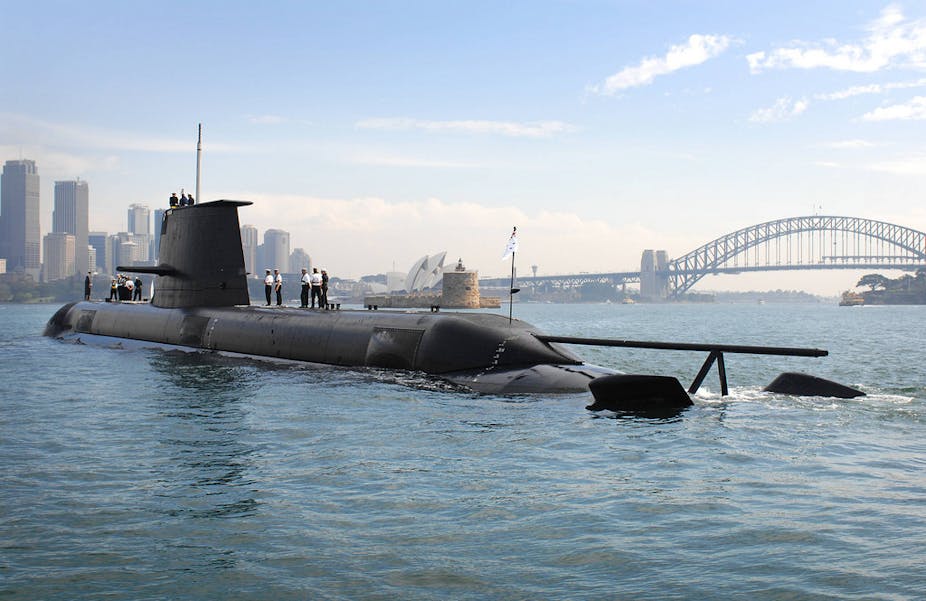It is not often that we witness strategic design in action, for the benefit of national security and economic growth. The challenges of translating good ideas into meaningful acts can be too great and the courage required to run the gauntlet of media reaction and public opinion can be lacking.
In the case of Australia’s future submarine program, the increasing evidence can be interpreted in such a way to suggest that the Coalition and the Defence Materiel Organisation (DMO) may have performed a well-executed feat of strategic manoeuvre.
It was always known that Australia would need a design partner to support the construction and maintenance of its next fleet of submarines. The experience acquired through the Collins Class program – and the lessons learned – put Australian industry in a leading position to take on a manufacturing and sustainment role, but a design partner was always necessary.
In his 2012 final review of the Collins Class sustainment program, British submarine expert John Coles acknowledged the progress made at submarine manufacturer ASC in improving productivity and building capability – an achievement subsequently acknowledged by the Defence Minister, David Johnston. To establish a foundation for Australia’s next generation of submarines the priority was to find the right design partner: one that would collaborate proactively with Australian industry. The obvious partner was Kockums – the designers of the Collins Class submarine, based in Sweden.
The problem, until July this year, was that Kockums was at the centre of a bitter dispute between its German owners and Sweden’s Defence Materiel Administration (FMV). Kockums had developed advanced technology for the new A26 submarine (now restarted as the NGU project) in collaboration with FMV but there was disagreement regarding intellectual property and project costs.
The escalation of the Crimean Crisis brought the issue to a head: Russia’s geographic proximity pushed Sweden to take action in defence of its sovereign capability. It needed to regain control of Kockums – a Swedish-owned company until it was acquired by a German competitor in 1999.
Tensions reached new heights on 8 April. At 7.30am, Sweden sent two military vehicles with armed soldiers into the Kockums shipyard in Malmö, southern Sweden. Their mission was to seize top-secret equipment; they completed their mission as site managers scrambled to lock the gates.
The dawn raid was seen as a key moment in the protracted “divorce” between Kockums and its owners – there was long-standing speculation that the Germans had acquired the company to control its market position and undermine the development of Swedish submarine technology. Finally, on 22 July the owners signed a deal with the Swedish Defence company, Saab, to sell the company. The Swedes had regained control.
As the drama unfolded and was finally resolved, the international community watched with interest. In Canberra, there was growing concern, given pre-election commitments to manufacture and sustain Australia’s next fleet of submarines “in country”. The Collins Class had proved itself to be of superior design, ideally suited to Australia’s unique climatic and strategic circumstances.
It had a record of strong performance in war-game scenarios, it had proven its superior stealth against the US Navy. The Collins Class design had given Australia a strategic naval advantage but with Kockums temporarily out of the picture, the Department of Defence had to devise an alternative plan.
From a strategic design perspective, the decision to enter discussions with Japan was, without doubt, the right move. Australia was keen to advance free trade negotiations and build an even stronger relationship with Prime Minister Shinzo Abe; there was also pressure from the US to forge closer links with Japan.
While an “off-the-shelf” solution would never work – Japanese submarines are designed for use in the northern hemisphere, not southern waters and with different transit requirements and so on – the discussions provided an opportunity to engage more closely with a key regional neighbour. They also provided an invaluable opportunity to debate and clarify costs, specifications and priorities.
The next step, in strategic design terms, is to undertake a contested definition study. Now that Australia has clarified its position, and its specific requirements, it can invite the four front runners to submit a response to its needs. Japan is among them alongside France, Germany and Sweden – now that Kockums has been returned to Swedish ownership.
Through a national debate that has effectively engaged with industry, academia, government and the Australian people the Department of Defence now has a much clearer set of priorities. The future submarine must be economically viable. It must meet Australia’s strategic intent. It must defend our national interests both on operations and in its design, manufacture and sustainment. It must demonstrate foresight and strategic design, contributing to innovation and national security. A strategic approach will now require that Japan, Germany, France and Sweden participate in a formal study to respond to Australia’s requirements.
This year’s series of visits to Japan by Warren King, the CEO of DMO, take on a new significance when seen in this light. Prime Minster Tony Abbott’s discussions with Prime Minister Abe also assume a different purpose - they can be seen as strategic engagement.
From an academic perspective, both have manipulated a complex set of circumstances to Australia’s benefit. Their next move will determine whether Australia continues to hold its position, securing strategic advantage.

